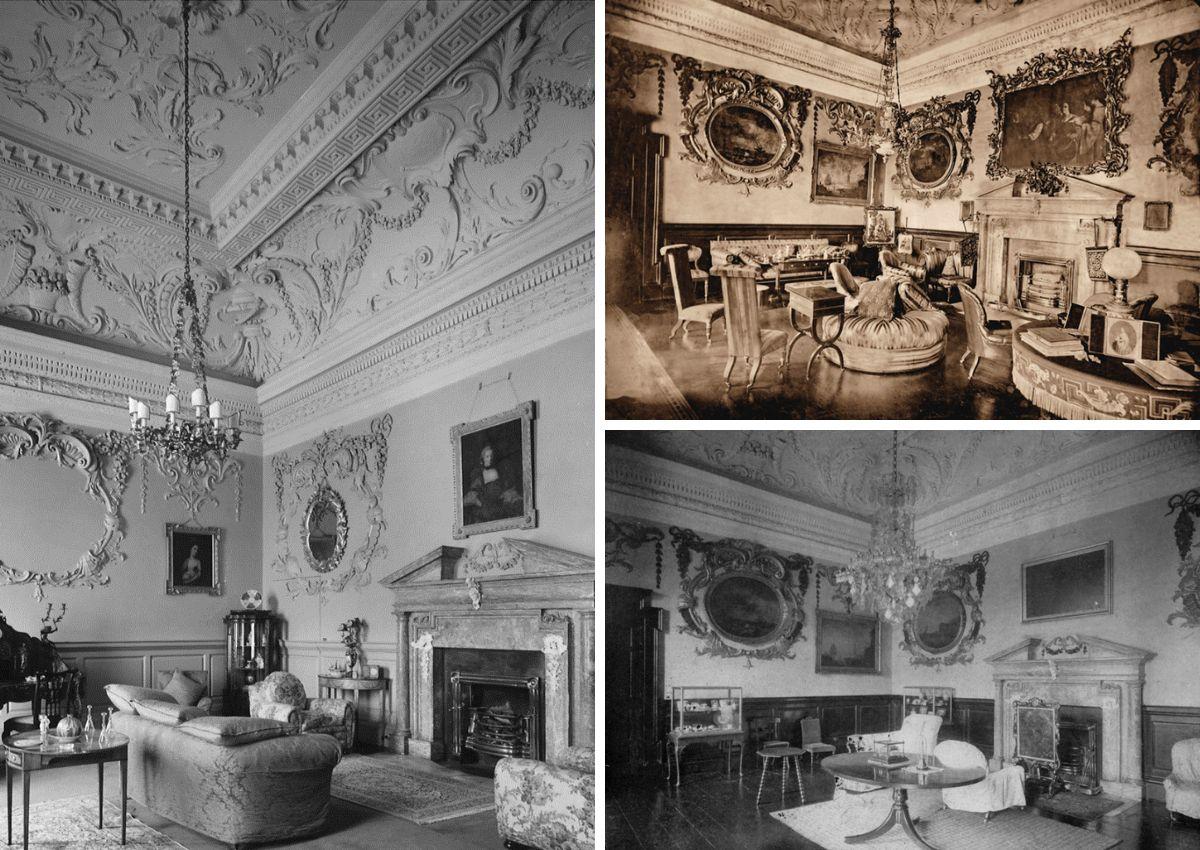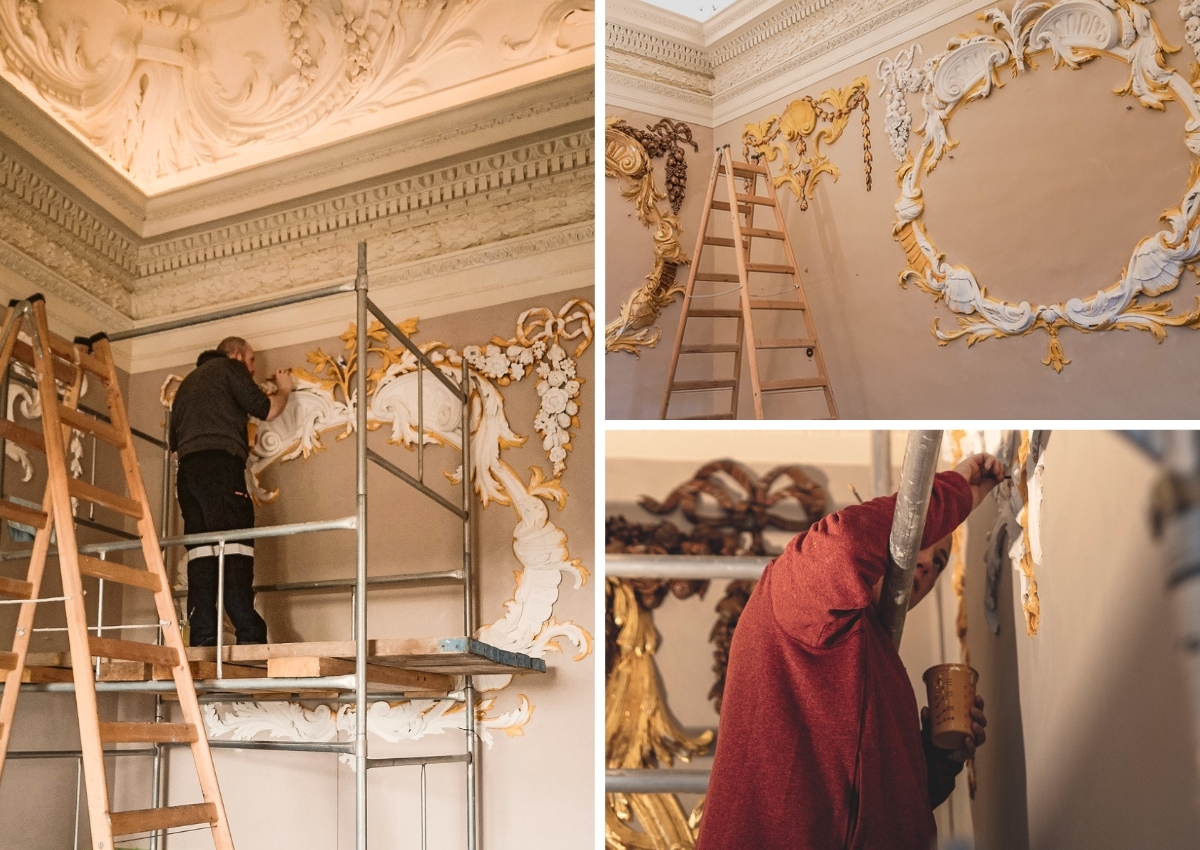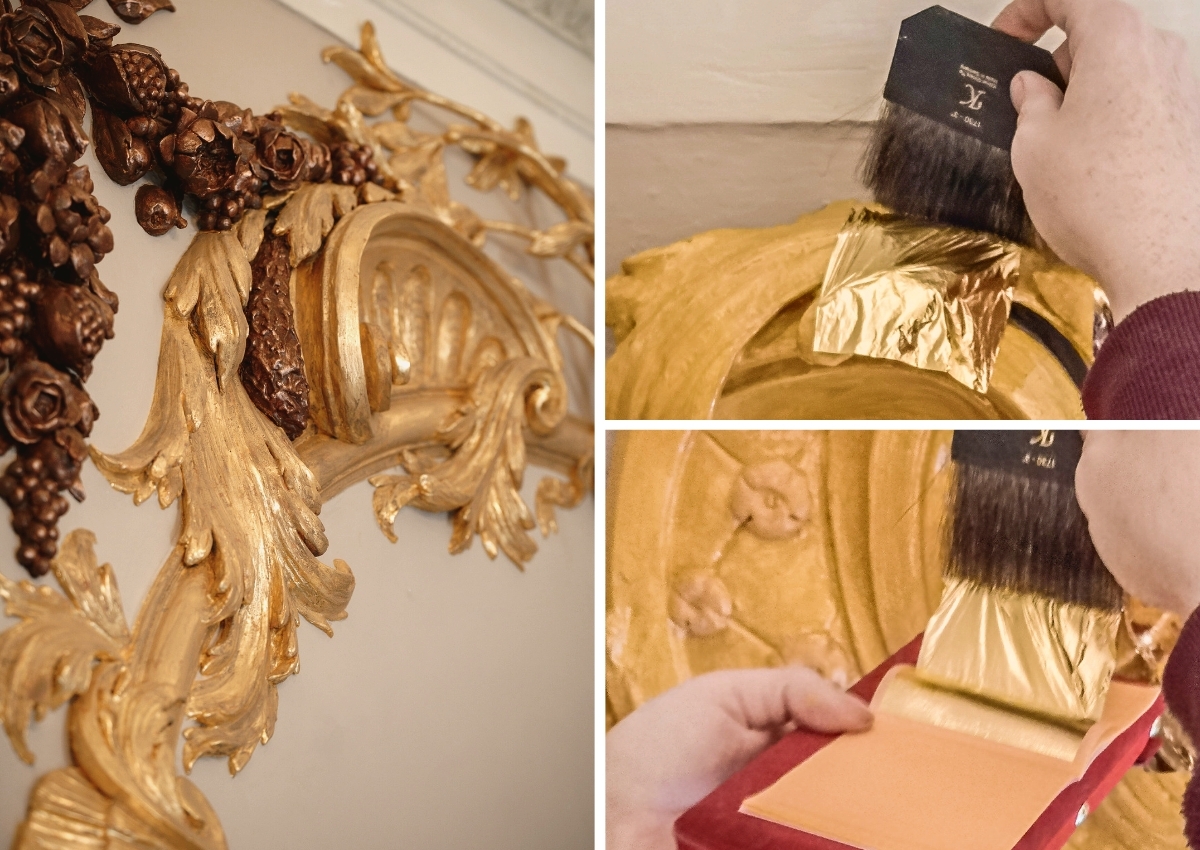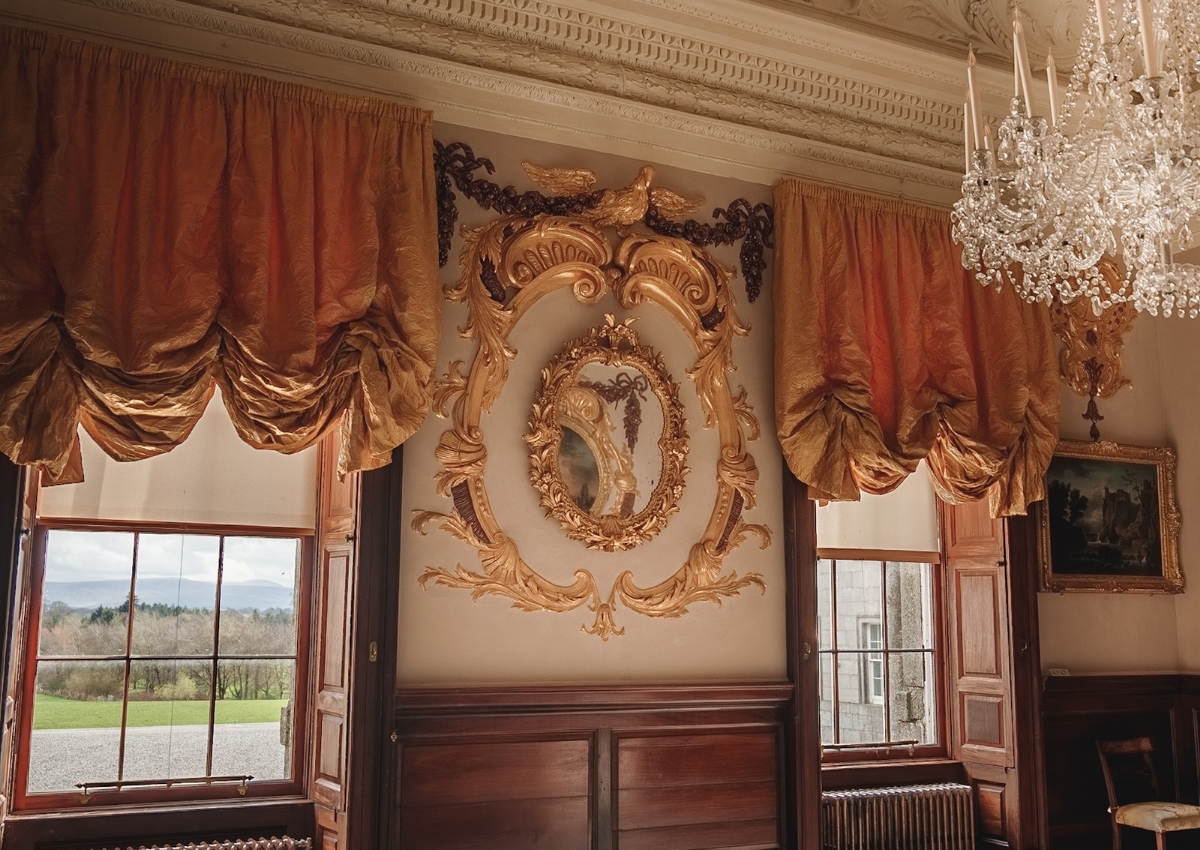Revel in the unique beauty of the newly restored Vernet Drawing Room at Russborough, a stunning ode to 18th century Ireland. From color scheme to picture hang, this carefully researched restoration project brings the room's original vision to life, including the masterpiece paintings it was designed to display.
An exquisite surprise awaits at Russborough with the grand unveiling of the fully restored Vernet Drawing Room inviting visitors to experience an alluring transformation - a timeless masterpiece of refinement and sophistication. Designed in an 18th century aesthetic, the room offers a captivating vision of a bygone era, finally made available to the public after careful and lengthy restorations. And while the restoration of the room's original design is a recent development, it has been a long time in the making.
In recent years, a series of chance discoveries, in-depth research, and analysis, have given us a complete understanding of the presentation of this incredible room over its nearly three-hundred-year history and the ability to recreate its beauty for future generations. From the colour scheme to the picture hang, these invaluable sources have guided us every step of the way in this important restoration project.

Russborough’s Drawing Room is the only one of its kind in Ireland to house the original works it was designed for, and this project has allowed us to reinstate the unique vision for the room, conceived to display eight Times of the Day paintings by celebrated French artist Claude Joseph Vernet (1714-1789).
As many as twelve paintings by Vernet featured in the Milltown collection as documented by John Preston Neale’s 'Views of the Seats of Noblemen and Gentlemen in England, Wales, Scotland, and Ireland' (1827), which provides a room-by-room inventory of the then 4th Earl of Milltown’s art collection. Neale records eight paintings by Joseph Vernet in the Drawing Room, however, over time, all eight were dispersed from Russborough. The four ovals, true masterpieces completed at the height of Vernet’s artistic power in 1751 and undoubtedly the inspiration for the interior's original creation, were sold in Paris in 1926 (by whom, is not yet clear), and were it not for the determination of Russborough's last owner, the room and its future story could have been very different.
When Sir Alfred Beit bought Russborough in 1952 the drawing room's design, with its elaborate stuccoed walls and empty cartouches, could have been easily removed to make room for his already impressive art collection. But he chose not to. Instead, recognising the importance of the Vernet interior, Sir Alfred resolved to live with the design, but only until he could track down the four oval landscapes and return them to the space that was created for them. It may have taken 16 years, but he finally succeeded in 1968 when they were traced to the collection of New York financier William Fahnestock. He secured the sale through Partridges – the largest single purchase of his collecting career.

Photographs from the 19th and 20th centuries document six Vernet Times of the Day in situ in the Drawing Room. What of the other two, was Neale mistaken in 1826? In 2020 the Apollo Foundation purchased two Studio of Vernet paintings – Morning and Evening – dated 1751, from the Killadoon House sale at Sotheby’s. These had provenance at Russborough, having been gifted to Lady Leitrim by Joseph Leeson, 2nd Earl of Milltown in the late 18th century.
Then, during a visit to Russborough, Historic Interiors Designer, Alec Cobbe, noted that these two paintings from Kiladoon were framed to match, ensuite, with the ovals – what if they were part of the original set? Only two possible spaces remained on the window wall - the paintings just fit; some might even call it a tight squeeze. Nevertheless, the evidence was compelling that they formed part of the vision for the room. Six of the original eight had returned home and our desire to fully reinstate the 18th century picture hang and the decorative scheme was growing.

Serendipity took us further when the owner of one of the final two paintings – both by Vernet Lacroix, dated 1751 – was interested in learning more about its provenance and contacted us. Material from the Russborough Archive documented that it, and its pendant, were sold with the house to Captain Denis Daly in 1931, and that he sold these two pictures in the Russborough Residue Sale of 1952. The Apollo Foundation were thankfully able to acquire the painting, bringing us to a grand total of seven and finally paving the way for the restoration of the Vernet Drawing Room to become a reality.
Faced then with a choice of leaving a gap, commissioning a copy of the still missing Vernet Lacroix (the Vernet is part of the National Trust collection at Uppark, West Sussex) or acquiring a suitable replacement. Our decision was made easier by the swift appearance of a Vernet Lacroix Morning, of identical dimensions and date coming on the market at Bonham’s. Naturally, we hope that eventually the entire Russborough set will be completed, but in the meantime the substitute, complete in new Russborough frame, makes a wonderful pendant to our Evening.

The original painting hang of the room is completed by a 17th century copy of Guercino’s Triumph of David, purchased by Joseph Leeson on his second Grand Tour and now on loan to Russborough from the Milltown Collection at the National Gallery of Ireland.

Over the last ten years a number of sources have explained the presentation of the Drawing Room by Russborough’s owners. The original Milltown scheme of soft white walls and ceilings, with the suite of Vernets lavishly surrounded with gilded and coppered stuccowork is documented in photographs from the 19th and early 20th centuries. The long survival of this scheme was established by forensic paint analysis completed by Catherine Hassal in 2015.
This established that the original 1750s scheme, devised perhaps by Russborough’s architect Richard Castle, survived until the entire room, floor to ceiling, was painted a putty colour by Denis Daly in the 1930s. In the following decades other colour schemes and treatments were adopted by the Beits, but the true glory and accomplishment of the stucco cartouches and other enrichments remained hidden by layers and layers of matte emulsion paint.

Led by Alec Cobbe and overseen by Russborough's Head of Collections & Conservation, Pauline Swords, decorative work began in November 2022. The first task was to return the dramatic baroque ceiling and the walls to their earliest colour scheme of soft white distempers. Next came the laborious and careful gilding of the stuccowork, completed by Restoration Artist, Theresa Cuddihy. It took over ten weeks to complete: three and a half weeks of prepping and sanding, one of painting, and a full six weeks to apply the gold leaf. The process involved removing paint drips from previous schemes, filling cracks, along with moulding and re-instating elements lost over the room’s long history.

As to why this took the time it did, Theresa explained that restoring any historical site is meticulous, especially given the nature of the Drawing Room's original design. The unusual decorative use of gilded and coppered areas meant different approaches were needed. ‘For the gilded areas, the surface was first painted with ochre, cut with zinc white, then shellacked, followed by the application of a size (glue) and then finally the gold leaf. The coppered areas were painted in pure ochre, then brown, before applying a copper powder mixed with varnish to create the final finish.’

The process is a time consuming one, glue used to adhere the gold takes roughly four hours to dry and is only usable for a brief window of time, a painstaking process by its nature. The gold is then given a final wash with paint and pigment powder to patinate and give it an aged appearance. Theresa shared the fascinating detail 'We used 3,650 individual sheets of 23.5 carat gold’, explaining that ‘the higher the quality of the gold carat, the less likely it is to tarnish, so we used as high a quality as we could get.’
While work onsite focused on the fabric of the room, restoration of the paintings and frames was undertaken at Hatchlands by Alec Cobbe and his team. All four Vernet ovals required significant conservation treatment, including removal of yellowed varnish and poor overpainting from previous restoration, retouching and varnishing, along with repair and re-gilding of the frames. With the gilding work complete, the paintings re-hung and the elegant furnishings back in situ, the Vernet Drawing Room is now open to the public.

A labour of love, passion and dedication, by everyone involved, this project can only be described as a revelation, quite literally. The long-anticipated renovation of the Vernet Drawing Room at Russborough has revealed something that has never been seen in our lifetime, with startling effect. Expertly restored to its original 18th century design, this extraordinary room brings together a harmonious blend of crasftsmanship, picture hang and iconic works, creating an experience unmatched anywhere in Ireland.
Explore the newly renovated Russborough with a guided tour, available seven days a week. Monday to Friday, tours run hourly from 12pm to 3pm, with additional tours on Saturday and Sunday hourly from 10am to 4pm. Book your tour online here and be one of the first to experience this exciting new renovation.
This restoration project was generously supported by The Apollo Foundation, Sheehan & Barry Architects and The Irish Georgian Society.
